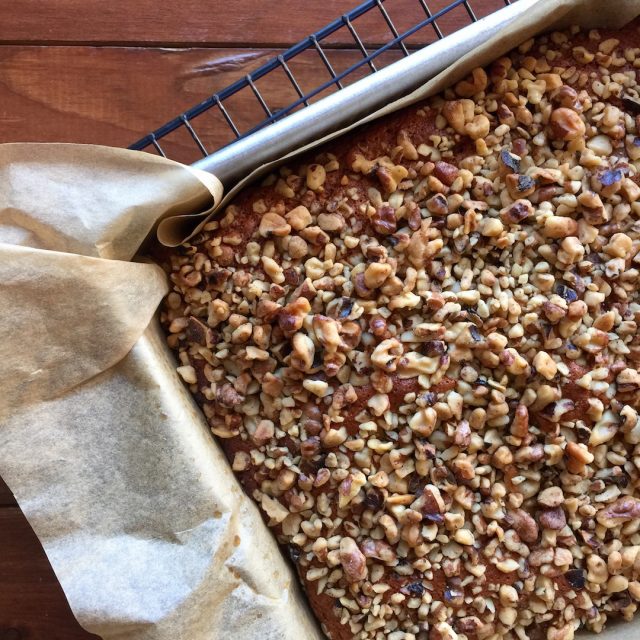collecting dots vs. connecting dots {honey spice cake}

The day is beginning to wake. The sky a chameleon, slowly morphing from deep navy to soft blue. I love watching this transformation. Years ago, I used to go out running at this early hour. The world went from still and quiet, to the squeaking wheels of trucks making their deliveries for the day. Commuters shuffling about, still wiping the sleep from their eyes, some clutching a canister of coffee for a life raft.
That old life feels so far from reality as I sit on my sofa in Maryland right now. We’ve been in the thick of adjusting to new schools, again. Virginia attends a tiny Montessori school, and hit the ground running. She’s always been my shadow, and while she’d much rather stay home with mama all day, she seems very content in her school environment.
Bella is back in the “system”, as I refer to public school. I watched a Seth Godin Tedx Youth Talk recently (Stop Stealing Dreams), and he expresses what I feel about it all so perfectly, regarding the state of education right now. And then there’s this Mother Jones’ article—a teenage girl realizes how broken the system is, and decides she’s not going to take it anymore. I want to raise strong women, courageous people who see the world is full of possibilities not impossibilities. Passion is the defining character that decides whether the glass is half full or needs a refill. As Godin touches upon in his speech, the current state of mass produced education does not value the individual, and their inherent individuality. Its focus is on conformity. Round holes demand round pegs.
And so, every day around here is reminiscent of the movie Groundhog’s Day. I wake long before the sun rises to restore my emotional reserves, much like preparing for battle. If I had a dime for every time I’ve been called the worst mother, or been told I don’t care about her, I’d be a rich woman.
I often wonder what life would be like if M were still alive. Would we fight the way we do now? I’m sure the answer is yes. I know the answer is yes.
This past Monday we celebrated Rosh Hashanah. I often joked with M that I was a better Jew than him, even with all my years of Catholic school. I always knew when the high holidays were coming up, and planned accordingly. I prepared my shiksa seders, which focused more on the significance and role food played than resembling any real seder. There was no shofar at our table, and my interpretation of bitter herbs during Passover was usually an arugula salad. We approached Christian holidays the same way, pouring them through a sieve to extract the essence of what they meant to us, and our family.
This year I decided to dig deeper into the meaning behind L’shanah tovah, the proper greeting for the Jewish New Year. It means to have a good year. Notice I did not say a happy year. Happiness all the time is not a sustainable goal. Life is filled with ups, downs, and the moments in between which seem rather ordinary, thought that, too, varies from person to person. It’s easy to get stuck in the tough moments, but how would we ever really appreciate the good ones if we had nothing to which we could compare them?
Our Rosh Hashanah dinner was far from your typical holiday meal. Much as I wanted to put up a brisket in the slow cooker, we had a lot of BBQ leftovers from the weekend. I decided to turn the extras into tacos for a shiksa seder that broke all the rules of kosher eating. The meaning would be in the message as we shared our thanks and appreciations at the start of the meal, something we do before dinner each evening.
I did want to include a link from our past, though, and took two cookbooks from my shelf. One was by Joan Nathan, and I smiled as I scanned the notes written in the margins. I mark up all of my cookbooks. When I find vintage ones with handwritten notes, I consider them extra special. It’s as though I’m keeping a bit of the previous owner alive by bringing their favorite recipes back to life. I hope my girls feel that way about my cookbooks when they grow up.
The other book I grabbed was by Edda Servi Machlin. I’ve written about this book before, in another life. I have a habit of stuffing notes and papers into all of my cookbooks. It’s as though Mikey beckoned me when the anniversary card fell to the floor. The cookbook had been his gift to me in 2009, a way of combining our pasts through food. I thumbed through the index to look for Rosh Hashanah desserts, and settled on a Honey Spice Cake. It didn’t matter that I was missing half of the ingredients necessary to make it. They were mostly dried fruits and a bit of brandy that none of us would’ve particularly enjoyed. I stripped away the recipe to its bare bones, the base essentially being a spice cake. It had an intriguing twist, with the addition of espresso to the batter. I wasn’t quite sure how this would taste, but was curious enough to leave it in my version. The honey is there to signify blessings for a sweet year, though the cake is more balanced in flavor than sweet. The espresso and honey combination adds a molasses-like taste, which was a nice surprise. I cut out refined sugars from the test kitchen a couple of months ago for the project I’m working on, and have missed the intensity molasses adds to baked goods. Another perk is that it’s dairy-free, a direction I’ve been leaning in for a while. I mean, unless we start talking about cheese. I just.can’t.give.that.up.
On first taste, this cake might not wow you. In fact, I recommend making it a day in advance, and letting it “cure”, wrapped tightly in parchment paper to stay fresh. If you think about dessert in terms of everyday life, not every day needs to have a “wow” factor. This cake reminds me of those moments in the middle. You know, the space that occupies time between good and bad. The moments when everything seems to be happening just as it should, at a pace that doesn’t disturb the structure of peace and harmony. Those are the real sweet spots in a good life.
Honey Spice Cake
Inspired by Edda Servi Machlin’s recipe in Classic Italian-Jewish Cooking (Ecco, 2005)
Serves 12
This recipe is barely recognizable from Machlin’s recipe, which is more akin to a richer, denser, fruitcake. What results here is a very light cake, with a drier crumb. I think it would be a lovely breakfast addition since it’s not sweet at all, though you can remedy that with a healthy dusting of powdered sugar on top. If you don’t have whole-wheat pastry flour on hand, regular all-purpose white will do just fine. And feel free to swap in granulated cane sugar for the coconut sugar.
1/4 cup olive oil
2 tablespoons coconut sugar
1/2 cup (160 grams) honey
Generous pinch of sea salt
2 large eggs
1 1/2 cups (225 grams) whole-wheat pastry flour
1 teaspoon (5 grams) baking powder
1/2 teaspoon (2 grams) baking soda
Few grinds of black pepper
1/2 teaspoon (2 grams) ground cinnamon
1/4 cup brewed espresso
1/4 cup orange juice
1 cup (133 grams) chopped walnuts
Confectioners’ sugar, for dusting (optional)
Preheat the oven to 375F (190C). Line an 8-inch (20-cm) square baking pan with a sheet of parchment paper long enough to hang over the sides. Spray the parchment with cooking spray, if you have on hand, for extra insurance that the cake doesn’t stick.
In a large bowl, combine the oil, sugar, honey, and salt. Beat with a whisk to blend. Add the eggs, one at a time, and whisk vigorously until thick and well blended.
Add the flour, baking powder, baking soda, pepper, cinnamon, espresso, and juice to the bowl. Using a wooden spoon or spatula, stir until mixed and there are no visible signs of flour. Pour the batter into the prepared pan. Sprinkle the walnut evenly over the top. Gently press them into the batter so they form a crumble-like topping. Bake for 30 minutes, or until the cake springs back when touched (or a metal skewer inserted in the center comes out clean). Let cool on a wire rack for at least 30 minutes, or overnight (I tend to be a night baker after tucking the kids into bed). Dust with confectioners’ sugar before serving, if desired.
